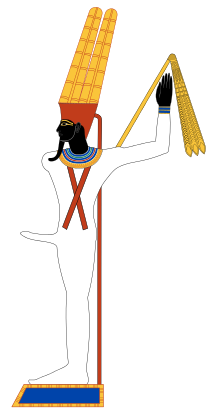Min
Min was the lunar god, of fertility and vegetation, god of rain, protector of merchants and miners, he represented the generating force of nature in Egyptian mythology.
- Egyptian name: What?.
- Greek name: Min.
- Greek Deity: Pan.
Iconography
He was represented as a man with black or green skin (colors that respectively symbolized regeneration and fertility) holding the phallus erect, on a pedestal, and wearing a crown of two long feathers and a flagellum. On some occasions he is represented as a black bull or a lion.
Mythology
Min was one of the oldest Egyptian deities, her cult dating back to pre-dynastic times; he hailed from Coptos, near the Wadi Hammamat caravan route where he was the protector of traveling merchants and miners. Min was a lunar god related to the calendar. He was linked to royalty as he ensured abundance.
He was considered the son of Ra, or of Shu, and Khentit-Iabet was his mother-wife; he formed a couple with Repit in Atribis, and with Aperetisis in Greek times, his son being Kolanthes. He also formed a triad with Kadesh and Reshep. On a stela in the Louvre museum he is cited as the son of Osiris and Isis.
Epithets
He was dubbed "Head of Heaven" and "Cloud Opener", in pre-dynastic times, as god of rain, and generating force; he was also the & # 34; Guardian of the roads & # 34;, as he was the protector of the merchants and caravans that traveled through the desert. Min, as a lunar god, was the 'Moon Protector'. He was called & # 34; bull of his mother & # 34;, as fecundator of the sky-goddess; he was also the "Lord of the Eastern Desert".
Syncretism
During the Middle Kingdom it was associated with Horus the Old as Min-Horus, and in the New Kingdom with Amun-Ra, being very popular. Many of Min's attributes were picked up by Amón, who was also sometimes represented with an erect phallus, to highlight his fertilizing power. He was associated with the serpent Kamutef in Luxor. As the god of fertility and vegetation, the Greeks associated him with the god Pan.
Worship
The cult of Min was one of the most enduring and widespread, being popular throughout Egypt in all periods, from the pre-dynastic to Roman times. The Greeks called the city of Ipu or Jent-Min, where he was worshipped, Panopolis, today's Ajmin. He was also revered in Jemnis and Coptos, where he was worshiped in the form of a white bull called Tep Hesepet during the New Kingdom.
He was the god of the month of Tybi, at the beginning of the Peret or sowing season. Furthermore, the last day of the lunar month was consecrated to Min and was called the day of 'Min's Departure'. During the New Kingdom he was very popular, celebrating in his honor orgiastic parties on the 28th of the month of Mesore.
The first crop of wheat was offered to him at the "Feast of the Ladder". Lettuce, due to its alleged aphrodisiac properties, was Min's sacred plant, and at the beginning of the harvest season, his image was taken from the temple to the fields. This formed the central part of the festival of the departure of Min , during which crops were blessed and gymnastic games were held in his honor.
| Min in hieroglyphic |
|
Contenido relacionado
Royal Monastery of San Juan de la Peña
Liberius
Mnemosyne

